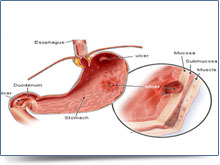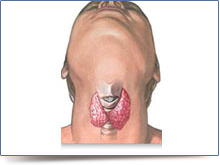
Laparoscopic Gall Bladder surgery (Cholecystectomy):
In this surgery there is removal of gall bladder and gall stones through several small cuts ( incisions) in the abdomen.
Surgeon inflates the abdomen with air or carbon dioxide in order to see clearly.
Before the removal of gall bladder a special x-ray procedure called “intraoperative cholangiography” is done which shows the anatomy of bile ducts.
Laparoscopic Appendix Operation:
 Laparoscopic appendectomy involves making of several tiny cuts in abdomen and inserting a miniature camera along with instruments.
Three or four incisions are made.
Patients with cardiac diseases and COPD would not be good candidates for this procedure.
Laparoscopic appendectomy involves making of several tiny cuts in abdomen and inserting a miniature camera along with instruments.
Three or four incisions are made.
Patients with cardiac diseases and COPD would not be good candidates for this procedure.

Operation for Peptic Ulcer:
There are two types of pepetic ulcer
- 1) Gastric (stomach)
- 2) Duodenal
Main aim of this operation is to remove the ulcer bearing part of stomach.
Duodenal ulcers occur as a result of too much acid being produced by stomach.
It can be achieved by cutting the nerves of stomach that stimulate acid ( vagotomy) or a part of stomach can be removed ( partial gastrectomy)

Operation for Intestinal Tuberculosis / Obstruction :
It is a form of abdominal tuberculosis. It can occur as a result of ingestion of infected milk or can be secondary to pulmonary tuberculosis. Patients are managed with full course of anti tubercular therapy.
Surgeries:
- Right quarter colectomy.
- Resection and anastomosis of small bowel.
- Stricturoplasty.
- Adhesiolysis.

Thyroid Surgery:
It is used to treat thyroid nodules , thyroid cancer, hyperthyroidism.
During this surgery part of thyroid gland is removed.
Total thyroidectomy, Thyroid lobectomy, Subtotal thyroidectomy is done.

Hernia:
It occurs when an organ pushes through an opening in muscle or tissue that holds it in place .
Hernias are most common on abdomen region.
It is caused by combination of muscle weakness and strain.
It can be repaired with either open or laparoscopic surgery.

Hydrocele:
It is an abdominal fluid collection in the scrotum between layers of tunica vaginalis.
If it is contralateral then it can electively repair at same time.
Endoscopy is done to corect congetial communicating hydrocele.
Surgeries of kidney stones and urinary tract stones:
Urinary tract contains :
- Two kidneys
- Two ureters
- Bladder and urethra
Surgeries:
Shock wave lithotripsy
Ureteroscopy
Percutaneous nephrolithotomy

Piles ( Haemorrhoids):
Haemorrhoids are swollen blood vessels in or around the anus and rectum.
Surgeries-
1) Haemorrhoidectomy - incision is made around anus to cut away the haemorrhoids .
Done under general anaesthesia.
2) Stapling - it is a minimally invasive produre.
Other surgeries- Laser
Rubber band ligation
Sclerotherapy
It is also known as fissure in ano, is a linear tear in lining of distal anal canal below the dentate line.
Treatment:
1. Topical diltizem Cream Versus botulinum toxin is a treatment for chronic anal fissure.
2. Botulinum toxin and topical nitroglycerin ointment.
All types of accidental injuries:
- Automobile accident injury.
- Whiplash
- Drowning
- Falls
- Toy related injuries
- Sports injury
- Burns
- Machinery accidents
- Suffocation
- Natural accidents
- Accidental eye injuries
All kind of specialized treatment and medicines will be provided for accidental injuries.
Management of Head Injuries:
- Medical Care - acute management
- We provide immediate assessement stabilization of airway and circulation.
- Reduction of intracranial pressure.
- Improves cerebral perfusion pressure.
- Phenytoin, Progesterone, Cyclosporin, Cannabinoids, Rosuvastatin medicines are used for treating head injuries.
Surgical Care:
Decompressive craniectomies are sometimes advocated.
Specialized care for Burn Patient:
Special care is given to burn patients in specialized burn unit. Wound is protected from air manipulation and contamination so that there is less pain and less need for analgesics.

Isolation Ward:
It is a separate ward used to isolate patients suffering from infectious diseases .
Several wards for individual patients are usually placed together in an isolation unit.
More precautions are generally taken with diseases of a higher mortality rate.
|
